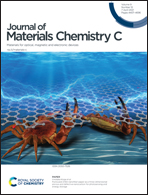Molecular engineering of twisted dipolar chromophores for efficiency boosted BHJ solar cells†
Abstract
Herein, we disclose the synthesis of new D–π–A push–pull chromophores (10 examples; 2a–2j) by tethering tetracyanoquinodimethane (TCNQ) as an auxiliary group instead of previously reported tetracyanoethylene (TCNE). This molecular engineering strategy of incorporating TCNQ on the D–π–A backbone permits a much-extended optical absorption in the near-infra red region compared to TCNE derived analogues. The impact of a dicyanoquinodimethane (DCNQ) moiety on the optoelectronic and electrochemical properties was calculated and correlated with density functional theory/time-dependent density functional theory (DFT/TD-DFT) calculations. The computations revealed an appropriate optical band gap as well as energy levels of the highest occupied molecular orbital (HOMO) and lowest unoccupied molecular orbital (LUMO) matching the requirement of donor materials for organic solar cells (OSC). Bulk heterojunction (BHJ) solar cells by exploring the synthesized chromophores as donor components along with phenyl-C61-butyric acid methyl ester (PCBM) as the acceptor showed power conversion efficiencies ranging between 5.22 and 7.09%. This boosted device efficiency based on TCNQ chromophores compared to TCNE counterparts (1.95 to 3.33%) is ascribed to the favourable molecular structure of the former to contribute for extended light absorption, elevated HOMO energies and better molecular parameters. With respect to cell fabrication, the best performed donor 2j in a 1 : 1 blend ratio with PCBM seems to be optimal as it exhibits good interdigitated nanostructures and film quality. Processing the best blend (2j:PCBM-1 : 1 wt/wt) by solvent vapour annealing (SVA) results in better surface morphology, self-ordered structure and charge transport properties to enhance the efficiency up to 7.79%. Overall, this paper validates the influence of the TCNQ acceptor in controlling the physical properties of D–π–A dipolar chromophores for enhanced OSC performance and could inspire the logical selection of this acceptor as an approach to boost the photovoltaic efficiency.



 Please wait while we load your content...
Please wait while we load your content...